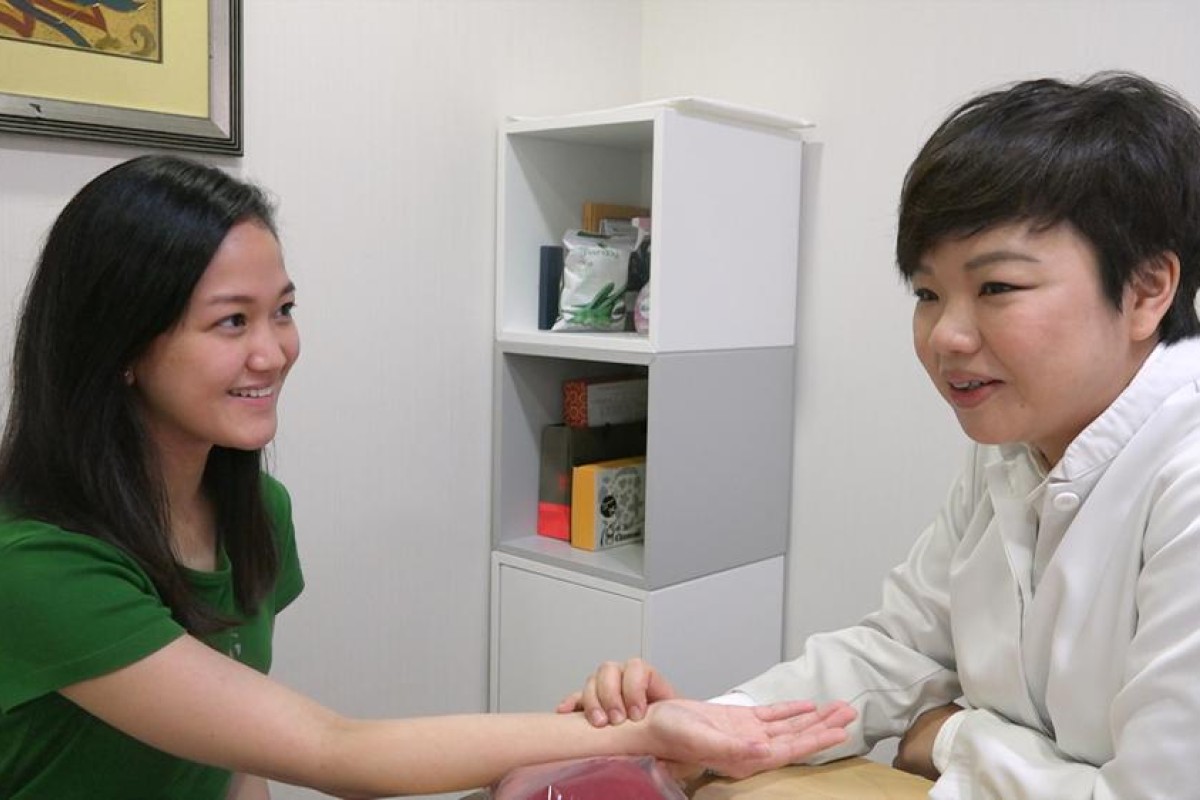
On the job: A doctor of Chinese medicine shows us the basics of acupuncture and other TCM techniques
Being an acupuncturist is about more than poking a few needles into random parts of a patient's body
 In less than a minute, Chan was able to diagnose that Nicole had a poor diet and lacked sleep.
In less than a minute, Chan was able to diagnose that Nicole had a poor diet and lacked sleep. My uncle, who is an acupuncturist, once asked me if I wanted to try having a needle inserted into my skin. That experience lasted about five seconds and is not one I’d ever care to repeat. You can understand why, then, I wasn’t very excited when I was told I would have to visit Chinese Essence Medicine in Tsim Sha Tsui for Young Post’s On the Job series, to get reacquainted with acupuncture therapy and to learn about other Chinese medical practices.
At her clinic, Dr June Chan welcomed me and showed me the acupuncture needles and glass jars that I would be using later. Before we got to those, she taught me how to check someone’s pulse, which is one of the first things she does when a client comes to see her.
Up until then, I had thought of checking someone’s pulse as something that could only tell you whether they were alive. But, in less than a minute, Chan was able to diagnose that I had a poor diet and lacked sleep – which I couldn’t exactly argue with.
Chan used three fingers to check the strength of my pulse at different points on both of my wrists. She explained to me that each pulse point told her something about a different part of my body. A weak pulse, she said, indicated a deficiency of some kind in the body, and is often seen in patients suffering from fatigue, insomnia, low blood pressure, or depression. A strong pulse may indicate the patient is experiencing stress, anger, high blood pressure, or a headache. I was impressed.
When it was my turn to take Chan’s pulse, I found that her pulse did, in fact, feel stronger at certain points of her wrist and weaker at others.
Chan then moved on to the next exercise, and she didn’t need to take my pulse again to know that my heart rate had shot up when she placed her acupuncture needles in front of me. Before I knew it, she had taken a needle out of its plastic pocket, sterilised a part of her hand with a swipe of some alcohol, and stuck the needle right into her skin. “See, easy,” she said.
On the Job: The surprising challenges of becoming a bubble tea master
To my horror, she twisted the needle in deeper, and gave it a couple of flicks to convince me that it was painless. I found that hard to believe – I was still traumatised from my first acupuncture experience with my uncle. She explained that the needle pierces the skin so quickly that you hardly feel a thing.
Chan then somehow managed to coax me into agreeing to give acupuncture another chance. I don’t want to say that she lied … but it wasn’t exactly painless. As she promised, the initial insertion happened so quickly that I hardly felt it; but as she gently pushed the needle deeper into my skin, I felt a strange, unpleasant sensation, like a dull electric shock, run down my arm.
It was then my turn to be the doctor. I don’t know which I hated more, having a needle inserted into my skin, or having to put a needle into someone else. I clearly lacked the confidence to insert the needle into someone else’s hand – my needle didn’t go in deep enough and just sadly listed to the side. It looks like I’m not likely to become a Chinese medical practitioner any time soon.
On the Job: Being a waiter is one big balancing act in many ways
After a couple more unsuccessful attempts, we decided to move on to fire cupping therapy, which involves soaking a cotton ball in almost pure alcohol and setting it on fire (yes, you read that correctly) inside a cup.
The trick to getting the cup to stick to the patient is to quickly move the burning cotton ball in and out of the cup, which heats and then cools the air inside and creates a vacuum. This makes the cup stick to the patient’s skin. I was a bit hesitant at first, but eventually got the hang of it.
I could safely say, by the end of the day, that I found my visit to Chan’s clinic very interesting. It takes a lot of training to enter her field, Chan told me, and (of course) you need to be okay with things like sticking needles in people. I learned a lot about traditional Chinese medicine during my day as an acupuncturist – most importantly, perhaps, that it is a career I should never pursue.
